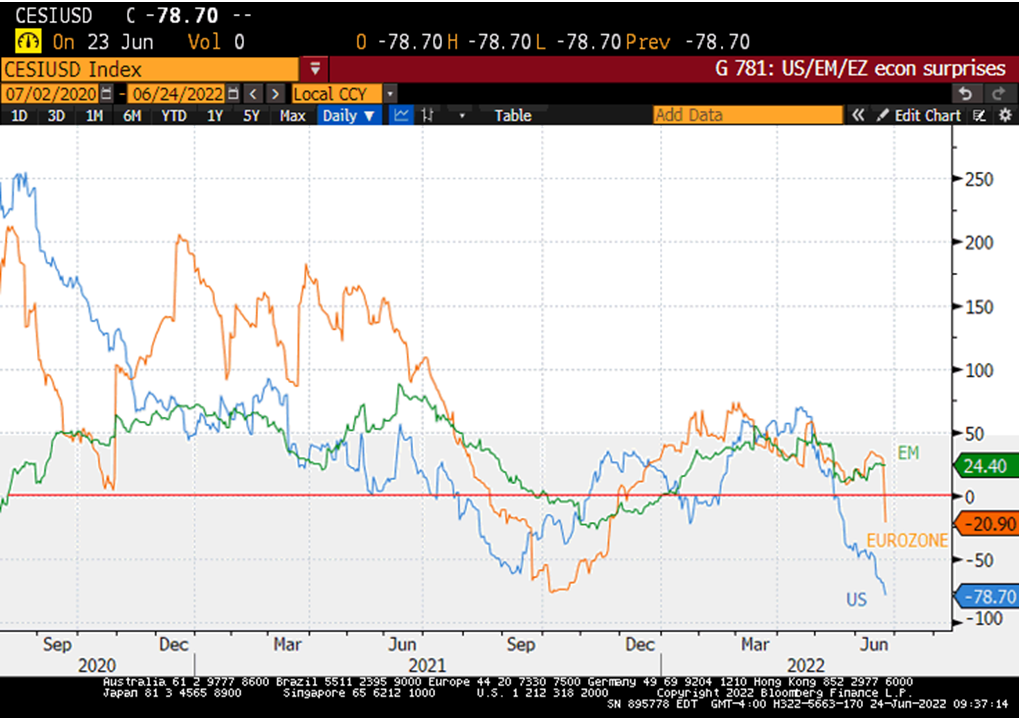By Natalia Gurushina
Chief Economist, Emerging Markets Fixed Income
Global Growth Outlook
The global growth dataflow remains predominantly negative, adding to recession concerns. A surprising drop in Germany’s business expectations survey reminded that Europe’s gas/growth story has further to run – so the recent very sharp decline in the economic surprise index for the region might be extended (see chart below). The economic surprise index for the U.S. is also not doing great – it moved even deeper into negative territory, and today’s downward revision of the University of Michigan’s survey might lead to further growth downgrades. Note that emerging markets (EM) as a whole are still doing OK on this metric – i.e. the economic surprise index is still positive. The question is whether EMs can buck the developed markets (DM) trend going forward.
China Growth Forecast Downgrades
The widening gap between China’s official 2022 growth target (around 5.5%) and the consensus growth forecast (cut further to 4.18%) is a major concern, because this is happening despite the easing Omicron drag, seemingly impressive stimulus initiatives (“33 measures”), and even some upside surprises in domestic activity. The next batch of China’s domestic activity gauges (on June 29) will be closely watched for signs of a more sustained rebound – the current expectation is that both the manufacturing and (importantly) services Purchasing Managers’ Indexes (PMI) will return to expansion zone in June.
LATAM GDP – Tentative Signs of Improvement
One EM region where we are seeing more “green shoots” is Latin America (LATAM). Brazil’s recession scenario is out the window – a sequential increase in June’s consumer confidence rhymes nicely with this view. A good thing is that the economy is improving but far from overheating, which gives the central bank room to gradually exit its very aggressive tightening cycle as inflation appears to be topping out. Colombia is now expected to expand by nearly 5% in real terms this year – from the market’s point of view, the key issue is that the incoming leftist administration uses the growth “cushion” wisely when implementing its policy agenda. Finally, Mexico’s economic activity started Q2 on a positive note – stronger than expected in April – albeit now we will have to factor in more rate hikes’ frontloading after yesterday’s 75bps increase. Stay tuned!
Chart at a Glance: Can EM Economic Surprises Stay Positive?*

Source: Bloomberg LP
*CESIUSD – Citigroup Economic Surprise Index USD: shows how economic data are progressing relative to the consensus forecasts of market economists.
Originally published by VanEck on June 24, 2022.
For more news, information, and strategy, visit the Beyond Basic Beta Channel.
PMI – Purchasing Managers’ Index: economic indicators derived from monthly surveys of private sector companies. A reading above 50 indicates expansion, and a reading below 50 indicates contraction; ISM – Institute for Supply Management PMI: ISM releases an index based on more than 400 purchasing and supply managers surveys; both in the manufacturing and non-manufacturing industries; CPI – Consumer Price Index: an index of the variation in prices paid by typical consumers for retail goods and other items; PPI – Producer Price Index: a family of indexes that measures the average change in selling prices received by domestic producers of goods and services over time; PCE inflation – Personal Consumption Expenditures Price Index: one measure of U.S. inflation, tracking the change in prices of goods and services purchased by consumers throughout the economy; MSCI – Morgan Stanley Capital International: an American provider of equity, fixed income, hedge fund stock market indexes, and equity portfolio analysis tools; VIX – CBOE Volatility Index: an index created by the Chicago Board Options Exchange (CBOE), which shows the market’s expectation of 30-day volatility. It is constructed using the implied volatilities on S&P 500 index options.; GBI-EM – JP Morgan’s Government Bond Index – Emerging Markets: comprehensive emerging market debt benchmarks that track local currency bonds issued by Emerging market governments; EMBI – JP Morgan’s Emerging Market Bond Index: JP Morgan’s index of dollar-denominated sovereign bonds issued by a selection of emerging market countries; EMBIG – JP Morgan’s Emerging Market Bond Index Global: tracks total returns for traded external debt instruments in emerging markets.
The information presented does not involve the rendering of personalized investment, financial, legal, or tax advice. This is not an offer to buy or sell, or a solicitation of any offer to buy or sell any of the securities mentioned herein. Certain statements contained herein may constitute projections, forecasts and other forward looking statements, which do not reflect actual results. Certain information may be provided by third-party sources and, although believed to be reliable, it has not been independently verified and its accuracy or completeness cannot be guaranteed. Any opinions, projections, forecasts, and forward-looking statements presented herein are valid as the date of this communication and are subject to change. The information herein represents the opinion of the author(s), but not necessarily those of VanEck.
Investing in international markets carries risks such as currency fluctuation, regulatory risks, economic and political instability. Emerging markets involve heightened risks related to the same factors as well as increased volatility, lower trading volume, and less liquidity. Emerging markets can have greater custodial and operational risks, and less developed legal and accounting systems than developed markets.
All investing is subject to risk, including the possible loss of the money you invest. As with any investment strategy, there is no guarantee that investment objectives will be met and investors may lose money. Diversification does not ensure a profit or protect against a loss in a declining market. Past performance is no guarantee of future performance.







